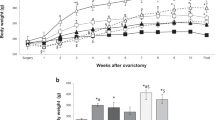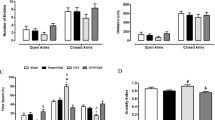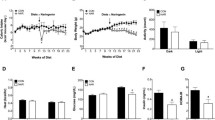Abstract
Diarylpropionitrile (DPN) is an estrogen receptor-β-specific agonist that has been linked to neuroprotection, preserving cognitive function with age, the suppression of anxiety-like behaviors, inhibition of cancer growth, and other positive properties. We hypothesized that DPN may have pro-longevity properties. DPN was administered via feed at a dose corresponding to approximately 3 mg/kg/day to ovariectomized female mice beginning at 7 months of age. Mice were followed for the duration of their lifespans while monitoring body mass, aspects of behavior, learning, memory, and frailty. DPN-treated mice gained more body mass over the first 2 years of age (17 months of the study). A test of voluntary running behavior at 24 months of age behavior revealed no deficits in DPN-treated mice, which were as likely as control mice to engage in extended bouts of wheel running, and did so at higher average speeds. DPN administration had anxiolytic-like effects when measured using an elevated plus maze at 9 months of age. A mouse frailty index was used to assess age-related changes. The correlation between age and frailty differed between control and DPN-treated mice. Overall, dietary DPN administration had some beneficial effects on the aging phenotype of ovariectomized female mice with few significant detrimental effects.






Similar content being viewed by others
References
Arnold S, Beyer C (2009) Neuroprotection by estrogen in the brain: the mitochondrial compartment as presumed therapeutic target. J Neurochem 110:1–11
Bains RS, Cater HL, Sillito RR, Chartsias A, Sneddon D, Concas D, Keskivali-Bond P, Lukins TC, Wells S, Acevedo Arozena A, Nolan PM, Armstrong JD (2016) Analysis of individual mouse activity in group housed animals of different inbred strains using a novel automated home cage analysis system. Behav Neurosci 10:1–12
Bansal S, Chopra K (2015) Differential role of estrogen receptor modulators in depression-like behavior and memory impairment in rats with postmenopausal diabetes. Menopause 22:1117–1124
Barreto G, Huang T-T, Giffard RG (2010) Age-related defects in sensorimotor activity, spatial learning and memory in C57BL/6 mice. J Neurosurg Anesthesiol 22:214–219
Barros RPA, Gustafsson J-A (2011) Estrogen receptors and the metabolic network. Cell Metab 14(3):289–299
Bean LA, Ianov L, Foster TC (2014) Estrogen Receptors, the Hippocampus, and Memory. Neuroscientist 20(5):534–545
Bourin M (2015) Animal models for screening anxiolytic-like drugs: a perspective. Dialogues Clin Neurosci 17:295–303
Brinton RD (2012) Translational animal models of human menopause: challenges and emerging opportunities. Endocrinology 153:3571–3578
Campos AC, Fogaca MV, Aguiar DC, Guimaraes FS (2013) Animal models of anxiety disorders and stress. Rev Bras Psiquiatr Suppl 2:S101–S111
Dutta S, Sengupta P (2016) Men and mice: relating their ages. Life Sci 152:244–248
Eckel LA (2011) The ovarian hormone estradiol plays a crucial role in the control of food intake in females. Physiol Behav 104:517–524
Ervin KS, Lymer JM, Matta R, Clipperton-Allen AE, Kavaliers M, Choleris E (2015) Estrogen involvement in social behavior in rodents: rapid and long-term actions. Horm Behav 74:53–76
Giroux V, Bernatchez G, Carrier JC (2011) Chemopreventive effect of ERβSelective agonist on intestinal tumorigenesis in Apc(Min/+) mice. Mol Carcinog 50(5):35969
Green MR, McCormick CM (2016) Sex and stress steroids in adolescence: gonadal regulation of the hypothalamic-pituitary-adrenal axis in the rat. Gen Comp Endocrinol 234:110–116
Hamilton DJ, Minze LJ, Kumar T, Cao TN, Lyon CJ, Geiger PC, Hsueh WA, Gupte AA (2016) Estrogen receptor alpha activation enhances mitochondrial function and systemic metabolism in high-fat-fed ovariectomized mice. Physiol Rep 4(17):e12913
Han SK, Lee D, Lee H, Kim D, Son HG, Yang J-S, Lee S-J V, Kim S (2016) OASIS 2: online application for survival analysis 2 with features for the analysis of maximal lifespan and healthspan in aging research. Oncotarget 7(35):56147–56152
Hong J, Stubbins RE, Smith RR, Harvey AE, Nunez NP (2009) Differential susceptibility to obesity between male, female, and ovariectomized female mice. Nutr J 8:11
Jacome LF, Gautreaux C, Inagaki T, Mohan G, Alves S, Lubbers LS, Luine V (2010) Estradiol and ERβ agonists enhance recognition memory, and DPN, an ERβ agonist, alters brain monoamines. Neurobiol Learn Mem 94(4):488–498
Lejri I, Grimm A, Eckert A (2018) Mitochondria, estrogen and female brain aging. Front Neurosci 10:124
Leo LM, Pamplona FA (2014) Elevated plus maze test to assess anxiety-like behavior in the mouse. Bio Protocol 4:1–8
Levine JA, Schleusner SJ, Jensen MD (2000) Energy expenditure of non-exercise activity. Am J Clin Nutr 72:1451–1454
Liao T-L, Tzeng C-R, Yu C-L, Wang Y-P, Kao S-H (2015) Estrogen receptor-β in mitochondria: implications for mitochondrial bioenergetics and tumorigenesis. Ann NY Acad Sci 1350:52–60
Mancuso M, Leonardi S, Giardullo P, Pasquali E, Borra F, Stefano ID, Prisco MG, Tanori M, Scambia G, Majo VD, Pazzaglia S, Saran A, Gallo D (2011) The estrogen receptor beta agonist diarylpropionitrile (DPN) inhibits medulloblastoma development via anti-proliferative and pro-apoptotic pathways. Cancer Lett 308:197–202
Meyers MH, Sun J, Carlson KE, Marriner GA, Katzenellenbogen BS, Katzenellenbogen JA (2001) Estrogen receptor-beta potency-selective ligands: structure-activity relationship studies of diarylpropionitriles and their acetylene and polar analogues. J Med Chem 44:4230–4251
Motylewska E, Stasikowska O, Melen-Mucha G (2009) The inhibitory effect of diarylpropionitrile, a selective agonist of estrogen receptor beta, on the growth of MC38 colon cancer line. Cancer Lett 276:68–73
Nikolic I, Liu D, Bell JA, Collins J, Steenbergen C, Murphy E (2007) Treatment with an estrogen receptor-beta-selective agonist is cardioprotective. J Mol Cell Cardiol 42:769–780
Oyola MG, Portillo W, Reyna A, Foradori CD, Kudwa A, Hinds L, Handa RJ, Mani SK (2012) Anxiolytic effects and neuroanatomical targets of estrogen receptor-β (ERβ) activation by a selective ERβ agonist in female mice. Endocrinology 153(2):837–846
Patisaul HB, Burke KT, Hinkle RE, Adewale HL, Shea D (2009) Systemic administration of diarylpropionitrile (DPN) or phytoestrogens does not affect anxiety-related behaviors in gonadally intact male rats. Horm Behav 55(2):319–328
Pravettoni A, Mornati O, Martini PG, Marino M, Colciago CF, Motta M, Negri-Cesi P (2007) Estrogen receptor beta (ERbeta) and inhibition of prostate cancer cell proliferation: studies on the possible mechanism of action in DU145 cells. Mol Cell Endocrinol 263:46–54
Rettberg JR, Yao J, Brinton RD (2014) Estrogen: a master regulator of bioenergetic systems in the brain and body. Front Neuroendocrinol 35:8–30
Rosenfeld CS, Ferguson SA (2014) Barnes maze testing strategies with small and large rodent models. J Vis Expt 84:e51194
Sarvari M, Kallo I, Hrabovszky E, Solymosi N, Rodolosse A, Liposits Z (2016) Long-term estrogen receptor beta agonist treatment modifies the hippocampal transcriptome in middle-aged ovariectomized rats. Front Cell Neurosci 10:149
Strong R, Miller RA, Antebi A, Astle CM, Bogue M, Denzel MS, Fernandez E, Flurkey K, Hamilton KL, Lamming DW, Javors MA, de Magalhaes JP, Martinez PA, McCord JM, Miller BF, Muller M, Nelson JF, Ndukum J, Rainger GE, Richardson A, Sabatini DM, Salmon AB, Simpkins JW, Steegenga WT, Nadon NL, Harrison DE (2016) Longer lifespan in male mice treated with a weakly estrogenic agonist, an antioxidant, an α-glucosidase inhibitor or a Nrf2-inducer. Aging Cell 15:872–884
Vasconsuelo A, Milanesi L, Boland R (2013) Actions of 17β-estradiol and testosterone in the mitochondria and their implications in aging. Ageing Res Rev 12:907–917
Walf AA, Frye CA (2005) ERbeta-selective estrogen receptor modulators produce antianxiety behavior when administered systemically to ovariectomized rats. Neuropsychopharmacology 30:1598–1609
Wegorzewska IN, Walters K, Weiser MJ, Cruthirds DF, Ewell E, Larco DO, Handa RJ, Wu TJ (2008) Postovariectomy weight gain in female rats is reversed by estrogen receptor alpha agonist propylpyrazoletriol. Am J Obstet Gynecol 199:67.e1–67.e5
Whitehead JC, Hildebrand BA, Sun M, Rockwood MR, Rose RA, Rockwood K, Howlett SE (2013) A clinical frailty index in aging mice: comparisons with frailty index data in humans. J Gerontol A Biol Sci Med Sci 69(6):621–632
Yakimchuk K, Hasni MS, Guan J, Chao MP, Sander B, Okret S (2014) Inhibition of lymphoma vascularization and dissemination by estrogen receptor b agonists. Blood 123(13):2054–2061
Zhao L, Mao Z, Schneider LS, Brinton RD (2011) Estrogen receptor β-selective phytoestrogenic formulation prevents physical and neurological changes in a preclinical model of human menopause. Menopause 18:1131–1142
Funding
This work was supported in part by a Natural Sciences and Engineering Research Council of Canada Discovery Grant to JAS.
Author information
Authors and Affiliations
Corresponding author
Ethics declarations
All procedures were approved by the Animal Care and Use Committee at Brock University, in compliance with CCAC guidelines.
Electronic supplementary material
ESM 1
(DOCX 16 kb)
About this article
Cite this article
Said, S.A., Isedowo, R., Guerin, C. et al. Effects of long-term dietary administration of estrogen receptor-beta agonist diarylpropionitrile on ovariectomized female ICR (CD-1) mice. GeroScience 40, 393–403 (2018). https://doi.org/10.1007/s11357-018-0038-7
Received:
Accepted:
Published:
Issue Date:
DOI: https://doi.org/10.1007/s11357-018-0038-7




